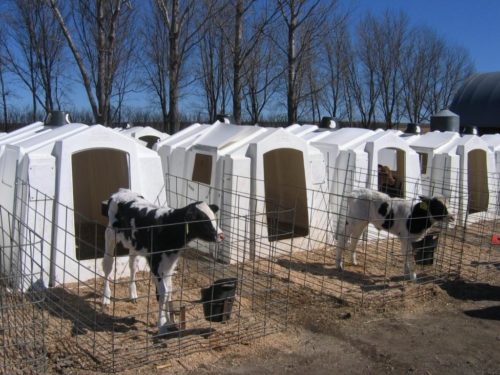Manage Hutch Calves with Heat Stress in Mind
Posted: July 20, 2020 | Written By: Anne Proctor, Ph.D

With the recent high temperatures, heat stress has been a concern on many dairies. Just like cows, calves experience heat stress, too. While we do not see reduced milk production, we do see reduced average daily gain, less efficient use of feed nutrients and an increase in treatments. Below are some tips to help you mitigate the effects of hot summer temperatures on your calves raised in hutches.
Position hutches so that the doors face north. With doors on the north, the hutch provides shade from the afternoon sun. Some farms change the orientation of the hutch for calves born after the first of May so that the last calves in south facing hutches are weaned by the end of June.
Take advantage of shady areas and natural airflow if possible. While you are probably used to having your hutches in one place, is there a better place for hutches in the heat of the summer? Do you have an area where calves could be in the shade in the afternoon? Maybe there is an area that often has a summer breeze and would be a good place to raise calves.
Open the vents and raise the backs of the hutches. Calf hutches can be like greenhouses in the summer. The sun heats up the air inside and unless there is opportunity for hot air to exit and cooler air to enter, they get hotter and hotter. Most calf hutches have vents that should be fully open in the summer. Simply raising the backs of the hutches can have a big impact on the temperature inside. Cement blocks work well, but I see people get creative with items already on the farm such as fence posts, rocks and firewood that work very well with no additional cost.
Feed water frequently and fill up the buckets. Calves should get a full bucket of clean water twice a day at a minimum. On hot days, refilling in the middle of the day may be necessary to ensure that every calf has water all the time. Calves that are consuming starter will drink about a half-gallon of water for every pound of starter they consume, so those older calves may need 2-3 gallons of water per day. Milk does not provide all the water that a calf needs; even the youngest calves should have free choice water available. Water is the cheapest feed you can provide!
Use summer bedding. Our goal for summer bedding is to keep calves dry. Wood shavings, wood chips or mulch and sand are great options for summer. These allow drainage but do not trap heat.
Manage the flies. In addition to being an annoyance and spreading disease, flies reduce weight gains. Using an insect growth regulator in your milk and starter will reduce the fly population but is only one step in a fly control program. Spraying insecticide in areas where flies congregate and using fly baits or traps will also reduce their numbers. Using a fly repellent on the calf can reduce the impact on feed intake. A successful fly control program includes killing adults, preventing larva from hatching and keeping flies off the calves.
Keep feed dry. Calves seem to slop more water in the grain pails when it is hot outside and the combination of heat and moisture allow growth of spoilage organisms in the wet feed. Feed only slightly more than the calf will consume between feedings and remove any wet feed that is left in the buckets.
Treat sick calves immediately. While this is good practice any time of year, it is especially critical during the heat of the summer. Dehydration can occur very quickly. We know that calves with scours need supplemental fluid, but that calf that just does not feel well and is not getting up for water can dehydrate also. Some farms make it a practice to offer a feeding of electrolytes in addition to the milk feeding to encourage more water intake and supply critical electrolytes and energy when it is hot.
What have I missed? Let us know how you reduce the impact of heat on your hutch calves!